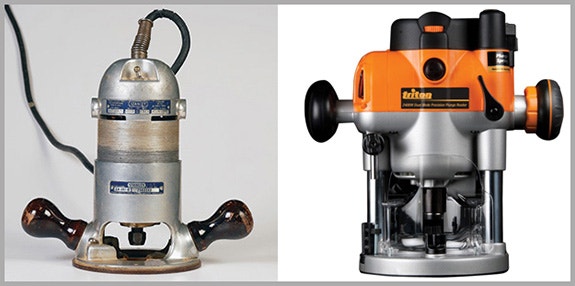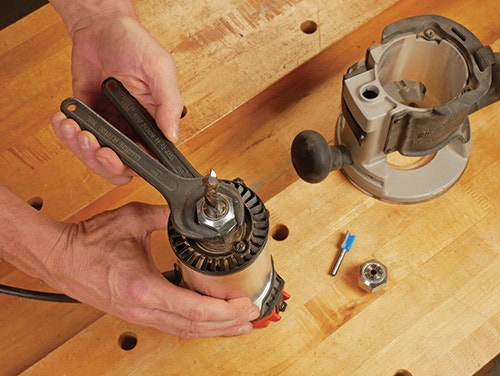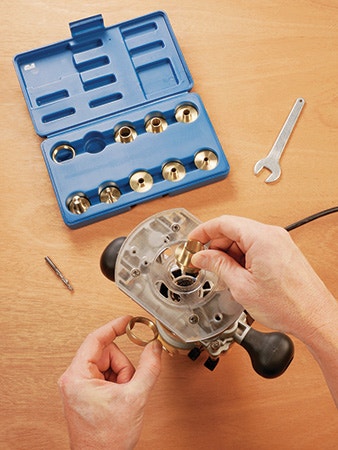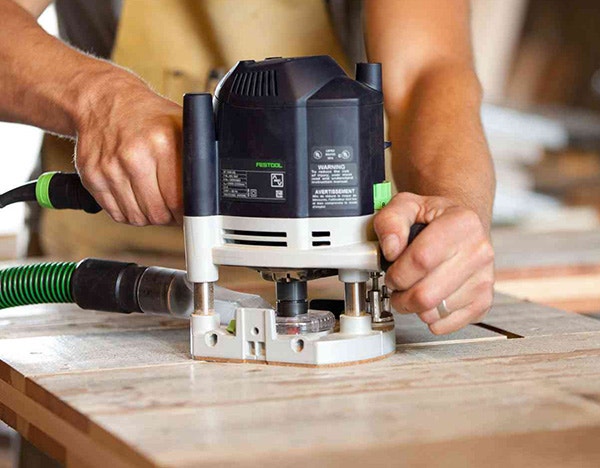Wood Router Basics
Whether you use a router made long before you were born or one of the technologically advanced models built today, either machine can perform a range of essential woodworking tasks that can’t be bested by any other power tool. If you’re a woodworking novice, a router should rank near the top of your “short list” of tools to buy first, even ahead of a table saw — routers are that useful.
A router can help you turn sharp edges into decorative profiles of all sorts. It will machine dadoes and grooves, rabbets, dovetails, mortises, tenons, box joints and more. Need to duplicate a bunch of parts? That’s no problem for a router and a template. It can even surface plane, joint edges flat, carve lettering, cut circles and bore holes. The “can-do” list goes on and on.

Router Base Options: Fixed Bases and Plunge Bases
Handheld routers feature two styles of bases; fixed and plunge.

Fixed-base routers feature a large collar that secures the router motor. The router bit height is adjusted by twisting or sliding the motor up or down and is locked in place wiith a lever or cam. Once you set the motor height, the base remains otherwise “fixed.” The bit height can be changed by releasing the lock and sliding the motor to a new height. Fixed bases can feature two handles or a single D-handle. They are also available for compact and cordless routers.

Plunge base routers turn that relationship on its ear: the motor clamps into a top housing on the base, and the housing can be raised or lowered on two spring-loaded metal posts to adjust the cutting depth — here, the motor is “fixed,” but the base plunges it to different depths. You control cutting depth using an adjustable rod that makes contact with a stepped and swiveling turret. Plunge bases can feature one or two handles. They are also available for some compact and cordless routers.
Manufacturers still produce a few dedicated plunge routers where the motor and base are integral. They were once commonplace, but most wood routers these days are modular: a removable motor pack fits both fixed and plunge bases to maximize versatility.
Router Collets Secure the Router Bit
The bottom end of the motor’s spindle that holds the cutting bit is tapered on the inside and threaded on the outside. A slotted, tapered collet fits into it and grips the shanks of router bits around their circumference like a vise.

A nut surrounds the collet and threads onto the spindle to tighten bits into place. Collets are sized to accept either 1/2″- or 1/4″-dia. shank router bits. Mid-size and larger routers often include both collet sizes.
How a Router Collet Works and How to Change a Router Bit
Other Helpful Features
Today’s routers are chockfull of good features that give them the edge over predecessor machines made 20 or more years ago. Almost all new routers have variable speed — and you’ll need to dial the speed down to operate large-diameter bits safely. Many motors have “soft start” that ramps up power to prevent jackrabbit starts that can jerk the tool in hand. Top quality routers also feature electronic feedback circuitry, which keeps the bit spinning at a consistent speed, regardless of the load being applied to the bit.
Some routers have spindle locks, so you can change bits with one wrench instead of two. Dust collection capabilities have improved, too, thanks to plastic shrouds that fasten or clip inside the base to corral the debris created by the bit; a port on the shroud connects to a vacuum hose. A few manufacturers even outfit their routers with LED lights that shine down into the bit area to help you see what you’re cutting — it’s a wonderful feature to have.
Guide Bushings

Below the metal router base, there’s a smooth plate called a base plate that fastens to it with screws. Router bases and their base plates will either have a round footprint or a combination of round and flat edges. The goal here is that you can feed the base plate along a straightedge or other guide surface consistently. The base plate’s smooth face also protects workpieces from marring during routing.
An indispensable feature of many base plates is that their center cutout is sized to accept router guide bushings , with 1-3/16″-dia. bushings being the industry norm. Guide bushings (also often called template guides, rub collars or guide collars) have a protruding bushing sized in a range of diameters from 5/16″ O.D. upwards to 1″ or more. They’re invaluable for all sorts of template work and even necessary for use with many dovetailing and mortising jigs.
Some larger-diameter bits won’t fit the openings of base plates designed for guide bushings, so an optional base plate with a larger bit cutout may be included with the router, too.
What Size Router Do I Need?

Routers subdivide into three principal machine sizes: full-size, mid-size and a category that goes by several names, depending on the manufacturer — “compact,” “palm” or “trim.” The delineation of full, mid or compact routers mostly has to do with the peak horsepower their motors will produce, but each size also has proportional and functional characteristics worth considering, too.
Full Size Routers - Full-size routers are the largest and most powerful options you can buy. They have either 3 or 3-1/4 hp motors, and they require larger plunge or fixed bases to hold the hefty motor packs. (Incidentally, here’s where you can still find the remaining new “dedicated” plunge router models.) A full-size router can accept any router bit made, from tiny roundover router bits to the largest panel-raising cutter router bits — and its motor delivers enough power to drive all of them with ease. But, the counterpoint to “fullsize” is that the weight and bulkier proportions of these routers can make them hard to maneuver by hand over small workpieces or along narrow edges. Oftentimes, routing successfully with a router held in hand requires some finesse. In these situations, a full-size machine weighing up to 15 pounds can make nimble control much more difficult.
Mid Size Routers - Mid-size routers are the industry’s answer to a “happy medium” among the routing family. Rated at 1-1/2 to 2-1/4 hp, with proportionally smaller bases than their bigger cousins and tipping the scales at several pounds lighter, midsize routers still pack enough punch to spin all but the biggest cutters. They can be outfitted with both 1/4″- and 1/2″-dia. collets, so you aren’t limited by the sizes of router bit shanks you can use. There was a period of time in the early 2000s when the industry put substantial R&D into developing combination kits that included both fixed-base and plunge-base options with an interchangeable motor pack. That trend caught on like wildfire, and its afterglow continues today. “Combo” kits offer well engineered fixed and plunge bases that will serve a broad spectrum of routing applications well, for a price that won’t break the bank. Premium mid-size models also include user-friendly features like soft start and feedback circuitry. This “family sedan” of the router market offers solid value to both novices and pros alike.
Compact Routers - Compact routers took a big step forward for woodworking in 2005 when Bosch brought its Colt™ Palm Router to market. Prior to that time, when woodworkers wanted the trimming or profiling capabilities of a router small enough to be used one-handed, the only real option was a laminate trimmer — a countertop fabricator’s tool. While these early “trim” routers were up to task for light-duty edge profiling work, their sub-1 hp motor capacity was limiting. Laminate trimmers also lacked plunge bases, because fabricators could simply tip the tool down into the work to punch through plastic laminate and start a cut. Mortising or controlled depth-cutting weren’t necessary tasks.
Compact routers have even blurred the lines between what must be done with a mid-size machine versus the smaller tool. While compact routers are limited to 1/4″-shank bits, They can be used for cutting mortises and for general template work. Their easy handling and ample power makes these machines surprisingly useful and unintimidating. They won’t replace a mid-size router by any means, but a compact router is really handy to have as an option.
Cordless Routers - The options for cordless tools are burgeoning these days, as manufacturers continue to pursue battery- powered alternatives for every benchtop, handheld and yard-and-garden power tool. You may know that Bosch, Makita, RIDGID and RYOBI now offer cordless compact routers among their 12- or 18-volt product lines, and more choices are probably on the horizon.

If you’re already invested in a battery platform, adding a cordless model might make sense, especially if electric outlets are scarce. Plus, the cord will never be in your way again.
Setting Up a Router Table
When workpieces are large enough to provide a stable platform under the tool — think wide boards, panels or sheet materials — or when you’re bringing the tool to an assembly like a cabinet carcass or a chest, holding the router by its handles may be your better or only practical option. Many dovetail jigs also require a router to be fed over a template on top of the jig. But, when you’re routing particularly small or narrow workpieces where the tool’s size becomes a hindrance, a second option is to invert the router and mount it underneath a router table instead.
This way, you can feed the workpiece across the table and past the bit without having the router’s weight and proportions working against you. Router tables also have the added benefit of a movable fence that can be set and locked to make straight cuts, like grooves, in from the edge of a workpiece. Fences with faces that open and close also allow you to present just a portion of a router bit’s cutting profile to the workpiece at a time, for cleaner and safer cutting passes. A miter slot in the table expands its capabilities even further for tasks such as dadoing and angled cuts. Or, attach a simple jig to your miter gauge, and a table-mounted router will cut box joints with ease.
A full-size router is ideal for a router table, because its weight is a non-issue in the table configuration, and a 3- or 3-1/4 hp motor offers plentiful power for any routing operation that comes your way.
Keep the inspiration coming!
Subscribe to our newsletter for more woodworking tips and tricks



